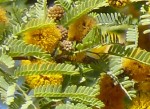 A native of Texas and Mexico, sweet acacia is also native to southern Asia and Australia and is an invasive species in Australia. It is grown in southern France for the flowers which provide a perfume ingredient. The globose, fragrant yellow orange flowers bear numerous stamens and are produced in clusters beginning in late winter and early spring continuing in diminished numbers into fall. A reddish brown to black woody pod 3-6” long follows and are attractive to wildlife. The light-green leaves are finely divided and borne on spiny branchlets. Plants can be grown as shrubs or multi-trunked small trees. Trees are useful as street trees because of their high drought tolerance and shrub forms are useful in shrub borders but should be located where small children will not be hurt by the sharp spines. Especially good in desert gardens.
A native of Texas and Mexico, sweet acacia is also native to southern Asia and Australia and is an invasive species in Australia. It is grown in southern France for the flowers which provide a perfume ingredient. The globose, fragrant yellow orange flowers bear numerous stamens and are produced in clusters beginning in late winter and early spring continuing in diminished numbers into fall. A reddish brown to black woody pod 3-6” long follows and are attractive to wildlife. The light-green leaves are finely divided and borne on spiny branchlets. Plants can be grown as shrubs or multi-trunked small trees. Trees are useful as street trees because of their high drought tolerance and shrub forms are useful in shrub borders but should be located where small children will not be hurt by the sharp spines. Especially good in desert gardens.
Type: Semi deciduous tree or shrub; may lose leaves to reduce water loss
Outstanding Feature: Flowers
Form: Vase-shped, rounded, spreading
Growth Rate: Slow
Bloom: Orange-yellow clusters of flowers beginning in early winter to late spring and continuing until fall with each new flush of growth.
Size: 15-25’ H x 15-25’ W
Light: Full sun
Soil: Average, well-drained
Hardiness: Zones 9-10
Care: Prune when young to develop structure.
Pests and Diseases: None of significance; may develop anthracnose
Propagation: Seeds, cuttings.
